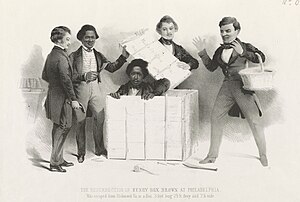City Crimes
City Crimes; Or, Life in New York and Boston is an 1849 novel by George Thompson, writing under the penname of "Greenhorn".
The novel was written for the working class and meant to give a shock to its readers through its use of graphic violence among several characters and sexual promiscuity, specifically among women.
Sensational urban stories such as City Crimes were extremely popular in the 1840s and 1850s, which is around when slave narratives gained traction in the public sphere.
Some of his exploits include thwarting robbers intending to steal from him and helping to rehabilitate other characters and turn them away from crime.
Early on, he's a rich man who abandons his life to help people, but is quickly whisked into the crime-ridden city and finds himself the victim of extreme violence.
The Dead Man is a character who, in order to conceal his identity, horribly disfigured and scarred his face through chemical means.
[4] He held several positions in the past, including that of a physician and temperance supporter, and reveled in immorality in these roles until he eventually turned to remorseless murder and crime.
When the book takes place, he lives in the underground "Dark Vaults", characterized by violence, cannibalism, sexual taboos such as incest, and decaying animals and human corpses.
This marked the beginning of her slip into social and moral decay, which culminates in her husband, Fred, forcing her into prostitution.
Frank is furious with her for cheating on him and separates from her, an act which Julia celebrates as it gives her newfound freedom to pursue her desires.
She kills the child of the affair with Nero soon after giving birth to it, then moves on from her relationship with Frank Sydney to a man named Mr.
[4] Her sister Josephine and mother Lucretia, however, are both incredibly deviant sexually and morally, and greatly overshadow her in the book.
Lucretia connives with Josephine to have her husband, Edgar Franklin, killed, so she may pursue her desires with pride, and encourages her daughters to do the same.
[2] This is seen in City Crimes specifically when the sexually active women, such as Maria Archer, die at the end of their arcs.
Thompson draws on the Gothic with his use of underground passages and hideouts, supernatural-seeming entities, and disfigured servants of evil such as The Dead Man and his hidden dwarf-like child "The Image".
[3] One criticism by Carl Ostrowski of City Crimes is that Thompson profits off of slave narratives, such as that of Henry Box Brown.
[1] Another criticism by Zaren White is that City Crimes is pornographic in its extreme interpretation of the Gothic genre and treats male and female sexuality differently.
A judge pardons another character, Dr. Sinclair, in a similar fashion, and is also depicted stealing money through the corrupt legal system.
In this way, Thompson utilizes and warps what was effective about Henry Box Brown's narrative to appeal to a different audience, including language such as "master" to keep a similar emotional attachment.
